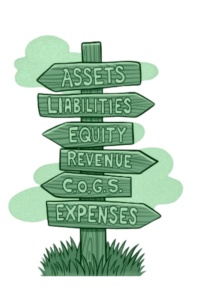While it may not seem like a significant part of your accounting structure, your chart of accounts is the foundation. Often overlooked, your chart of accounts provides financial clarity in your business and supports informed decision-making.
Organization
It’s important that your chart of accounts is well organized. Your Chart of accounts will start with your asset accounts (current, then long-term), followed by liabilities (current, then long-term). After liabilities, the balance sheet portion of the chart of accounts is completed with the equity accounts.
Following the balance sheet accounts, you’ll have your profit and loss accounts, starting with Revenue accounts, then Cost of Goods Sold. This results in your gross profit. Operating expenses come after gross profit. Then, your chart of accounts is finished with Other Income and Expense accounts.
|
Balance Sheet Accounts |
Profit & Loss Accounts |
|
Current Assets |
Revenue |
|
Long-Term Assets |
COGS |
|
Current Liabilities |
Operating Expenses |
|
Long-Term Liabilities |
Other Income |
|
Equity Accounts |
Other Expenses |
As you organize your chart of accounts, you should think about grouping accounts together in ways that make sense for reviewing. For example, as you’re setting up your expense accounts, it makes sense to put labor costs together vs having Benefits at the top, Taxes 20 accounts below, and then Wages at the end. It’s more difficult to evaluate your total costs in an area if you’re not combining them in groups that make sense together.
Be Strategic
As you’re setting up your chart of accounts, think simple. Don’t use 2 accounts, when one will do. While it’s good to break out revenue and expenses into categories for proper evaluation, you want to make sure that you’re not breaking them down so much, that the breakdown no longer holds value. For example, you don’t need to setup an account for Pens, Paper, Kitchen Supplies, and Bathroom Supplies, you can just use one account for Office Supplies. However, if you purchase a lot of computers or computer parts, you may want to have an Office Supplies account and also have a Computer Supplies account. Think about having enough accounts that you can evaluate key areas of your business, but not so many that the tracking becomes cumbersome and the value is diluted.
A key component of your chart of accounts is the numbering system. Make sure you use account numbers. This helps you to organize the accounts, regardless of the account name. A typical chart of accounts will use the following numbering system:
-
-
-
-
-
-
-
-
-
-
- Assets = 10000s
- Liabilities = 20000s
- Equity = 30000s
- Revenue = 40000s
- COGS = 50000s
- Expenses = 60000s
- Other Income = 70000s
- Other Expenses = 80000s
-
-
-
-
-
-
-
-
-
Consider leaving space in your numbering system for changing needs. As your business grows or adapts to different business offerings, you may need to add accounts, so leave space between
accounts to add different levels or new accounts.
Sub Categories
And finally, consider using sub-accounts. Sub-accounts allow you to group different types of activities and accounts together. For example, you can group your marketing expenses together, labor costs, and office-related expenses. You can also group revenue accounts by a particular type of service or cost of goods sold accounts by different categories – materials, labor, others.
Put It All Together
While there are pretty standard chart of accounts used in business, your chart of accounts should be tailored to your business. Start with a standard chart of accounts, then customize the accounts to work with your business. Your chart of accounts should work for you. You need to consider what you want to look at to manage your business. While you do need some pretty standard accounts and tracking for tax reporting or other compliance reporting, this can be managed through grouping accounts together at the time of reporting. It is more important that you structure your chart of accounts to manage the business and then your CPA can pull together what they need for tax reporting.
A well-organized chart of accounts is the backbone of your accounting system. It provides structure, clarity, and efficiency, supporting accurate financial reporting, decision-making, and compliance. Investing time and effort into creating and maintaining an organized chart of accounts is a crucial step toward financial success and stability.
Written by: Shauna Huntington
Posted in Accounting Solutions, General, Small Business Accounting
